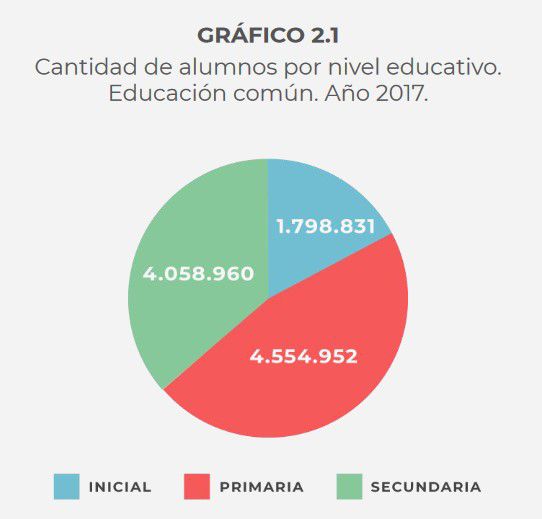General data on education in Argentina
Argentina is one of the most developed countries
in Latin America. It has an area of 2,780,400 square kilometers and a
population of 44 million people in 2017. Its human development index reaches
0.83 points, the second highest in Latin America just after Chile.
Its educational sector is divided into: initial education
(from 3 to 5 years), primary (from 6 to 12 years), secondary (from 13 - 18,
equivalent to secondary and high school) and college, which is not included in
this report.
As of 2017, the total number of students from initial
education to secondary education is 10,641,971. Primary level had 4,554,952
students and 99% coverage, what is considered universal coverage. In the same
way, secondary education reaches 4,058,960 students, with a 89.5% coverage, an
increase of 35% against 1996. The initial level had 1,798,831 students, showing
a 67% growth in its enrollment since 1996. In both cases, the significant
increase in enrollment is related to the legal changes for the compulsory
nature of these educational levels and the significant increase in public
investment in education. [1].
 [1]
[1]
Public and private education
Of the total students in the country, 70% are in
the public sector, while the rest study in private schools. Of the teachers,
75% are concentrated in the public (or state) sector, while the rest is in the
private sector. This gives a higher teacher-student ratio in the public sector.
[2].
Argentine education is still mostly public,
however, the private sector in education has had significant growth in recent
years, with a growth rate of 87% compared to the period 2003-2010 (data from
2014). [2].
Education in Buenos Aires
If we go regionally, we see that the majority of
both teachers and students are in Buenos Aires. Of the total of almost 11
million students, just over 4 million study in the province of Buenos Aires
(4,087,614), of which 2,495,789 are in the metropolitan area and 701,656 are
right in the administrative capital (CABA). [2].
Public spending on education
Public investment in education grew steadily from
2005 until reaching its peak in 2015 and starting a slight regression. In 2005,
spending as a percentage of GDP was 4%, while in 2015 it was 6.1%, and on 2017
it dropped to 5.6%. 80% of provincial spending on education is dedicated to the
payment of personnel, while a 12.5% are transfers to the private sector and
3.4% are capital investment. [1].
The student-teacher relationship has also improved
in the country. This went from 15.4 students for each teacher in 1998 to 12.2
in 2017. This data becomes even more important if the initial level is
excluded, since the ratio is 11.5 at the primary level and 9.6 students for
each teacher at the secondary level. [1].
Internet at home
The use of the internet is very important for
education in the context of the pandemic and for the future of education. As of
2018, 19.5% of primary-level students did not have internet access at home, the
same as 15.9% of secondary-level students. The three provinces with the highest
internet access are (in order) Buenos Aires, La Pampa and Tierra de Fuego. [3].
Another figure to compare is the percentage of
15-year-old students with internet at home, which in the case of Argentina is
85%. At the regional level, Argentina scores higher than Mexico and Colombia
with, but lower than Brazil with 91%, Chile with 90% and Uruguay with 88%. [3].
Opportunity for YEII
The education market in Argentina, public and
private, is highly attractive for its size and its maturity considering high
investment, high connectivity and its growth even during recession. It offers a
great opportunity for collaboration and creation of international alliances.
It is also worth noting the change in the
political and economic situation that the country is currently undergoing. The
return of Kirchnerism by the hand of the newly elected president, Alberto
Fernández, augurs a new expansion in public investment in education, such as
that experienced between 2005-2015 (years of Kirchnerism) (see Public
investment in education). Also important is the economic stabilization derived
from the renegotiation of the Argentina’s foreign debt.
Argentina, as well as any other country that seeks
to be in the educational vanguard (particularly during the context of a
pandemic), should make use of technology applied to education and specialized
project-based curricula and methodologies.
That is why YEII has been collaborating with
groups interested in promoting education in the country hand in hand with
technology. The conversations are on the path of a deep
and lasting relationship, which will undoubtedly benefit both the schools and
communities of the country, as well as our growth and international experience.
Sources:
1.
https://cms.argentinosporlaeducacion.org/media/reports/El_estado_de_la_educacion_Argentina.pdf
2.
https://www.infobae.com/2016/04/25/1806884-radiografia-la-educacion-argentina/
3.
https://www.elentrerios.com/actualidad/provincia-por-provincia-cuntos-estudiantes-tienen-internet-en-su-casa.htm
Based on figures from the report "How many students have access to the Internet at home in Argentina?" [¿Cuántos estudiantes tienen acceso a Internet en su hogar en Argentina?], from the Observatorio Argentinos por la Educación.